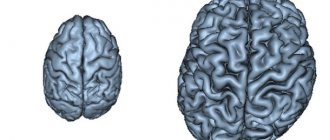Definition 1
Neuroses are most often shallow mental disorders that arise due to the impact of various types of psychological trauma on the individual.
Currently, a fifth of the world's population suffers from neuroses. During adolescence, girls suffer from neuroses more often than boys. This affects self-esteem, attitude towards oneself and relationships with others. Family problems are often to blame for this. Some children begin to develop neurosis, others suffer from disturbances in behavior and desires.
Causes of neuroses in adolescents
Children and adolescents suffer from neuroses due to various provoking factors. The most common reasons:
- conflicts with parents;
- unfavorable family situation (alcoholism of father/mother, living with stepmother/stepfather);
- constant irritability;
- minor brain disorders caused by difficult pregnancy and difficult childbirth;
- high demands on yourself;
- conflicts with peers;
- hypersensitivity and emotionality;
- hormonal surge;
- lack of attention.
- symptoms and signs of neurosis and adolescents
- distrust, suspicion;
- sleep disturbance;
- low self-esteem;
- fear, fear, uncertainty;
- irritation due to fatigue;
- pathological uncertainty, indecision;
- increased loads;
- excessive touchiness;
- decreased concentration.
Finished works on a similar topic
- Coursework Neurosis in a teenager 420 rub.
- Abstract Neurosis in a teenager 280 rub.
- Test work Neurosis in a teenager 200 rub.
Receive completed work or specialist advice on your educational project Find out the cost
Causes of nervousness and irritability in a child
Irritability and nervousness in a child can occur due to fatigue, lack of sleep associated with sleep disorders, as well as for a number of other reasons:
- absence or lack of parental attention,
- unbalanced diet, lack of vitamins or microelements necessary for the proper development of the body,
- lack of physical activity,
- unsatisfactory living conditions for the child,
- narrow circle of friends,
- excessive passion for watching television or playing computer games, which leads to irritability in adolescents.
Manifestation of neuroses
Nervous disorders in children and adolescents can manifest themselves in different ways. They come in the following types:
- Nervous tic. Neurosis in children and adolescents can manifest itself in the form of unconscious twitching of limbs, eyes, mouth, cheeks, shrugging of shoulders, unreasonable movements of hands, and smacking. A nervous tic that occurs when a child is absolutely calm is one of the signs of a nervous disorder. With active activity, the tic disappears.
- Poor sleep or insomnia. If a child has not previously had problems with sleep, he always got enough sleep, but suddenly he began to toss and turn frequently, sleep restlessly and wake up in the middle of the night, or even stopped falling asleep altogether, you should also pay attention to this symptom. In this form of the disorder, children also talk during sleep, and it becomes very realistic. There are also cases of sleepwalking.
- Stuttering. This form of the disorder occurs in children around the age of three, but can also occur later. During this period, the baby learns to talk. It is very important not to overload the child, as overexertion may cause him to experience stress, which will cause parents a lot of anxiety in the future. Stuttering also often occurs during prolonged separation from loved ones. If you do not pay attention to this problem in time, it will be much more difficult to cure stuttering in the future.
- Anorexia. This form of nervous disorder is expressed in a reluctance to eat food. If a child was forced to eat in childhood, then in adolescence the child will begin to strive for a slim figure, and therefore may refuse to eat at all. It is best to treat anorexia in the early stages of manifestation, as adolescents show greater independence and believe that they know better what they need.
Too lazy to read?
Ask a question to the experts and get an answer within 15 minutes!
Ask a Question
Incorrect behavior of parents under the guise of strong love and desire to help also often leads to the development of neurosis. In order to prevent the development of the disease and its appearance, you cannot only note the child’s shortcomings, constantly pointing out weaknesses, thinking that this will benefit the child. In this case, you need to concentrate on the advantages. You cannot send your child to schools, clubs and other sections that he does not like, creating an overload. Also, you should not overprotect the child. But the most important thing that must be observed so that the child does not have psychological problems is maintaining a friendly atmosphere in the family and the absence of scandals. It is necessary to give the child the opportunity to exercise independence. You should not put a ban on questions regarding puberty and love relationships.
Physically, neuroses can manifest themselves in the form of depression, insomnia, tearfulness, lack of appetite, panic attacks, and headaches.
Teens may also suffer from hyperhidrosis, which causes an increase in sweat production. The pathological process is often accompanied by tachycardia. When the disease occurs, adolescents may also experience a feeling of lightheadedness and cramps in the intestines. Hyperemia (redness of the skin) is also common.
Symptoms
Each clinical form of neurasthenia has different symptoms. Of course, the more the disease progresses, the more pronounced and severe the symptoms.
Symptoms of the hypersthenic form:
- Constantly depressed mood
- Apathy
- Prostration _
- Low interest in work and life
- Slight pressure in the temples
This type of disease is quite easy to treat. After short therapy, the patient recovers and begins a full life.
Symptoms of the irritant form:
- Rare headaches
- Dizziness
- Nervous exhaustion
- Pain of varying intensity in individual organs or throughout the entire body
- Insomnia
- Rotations of objects in the head
- Increased heart rate
An important development of this form of neurasthenia is the character of the patient. If a person has a choleric temperament , then diseases of the nervous system may manifest themselves frequently.
Symptoms of the hyposthenic form:
- Intense pain in internal organs and head
- Strong pressure in the temples
- Constant insomnia
- Problems in the sexual sphere
- Tachycardia
- Pale skin
- Emotional experiences and anxiety during sudden weather changes
In addition to general symptoms, neurasthenics can individually experience various unpleasant symptoms:
- Mental disorders , obsessive thoughts and phobias
- Decreased mental capacity
- Heat and cold in the extremities and various parts of the body
- Tinnitus
- Darkness in the eyes
- Reducing the duration of sexual intercourse or weakening potency
- Epigastric pain after eating
- Vomiting and diarrhea
- Increased heart rate while eating
- Pain in the heart
In both children and adults, symptoms usually appear at night , when the patient is alone with himself.
Such disturbances in well-being lead to mental disorders, fear of death and thoughts of suicide. Neurasthenia can progress very quickly, leading to the death of a person. Children who become ill with this disease completely change their behavior; this should not go unnoticed by their parents.
Symptoms of neurasthenia in children
- Fear darkness and monsters
- Hallucinations
- Stuttering
- Stupor
- Decreased appetite
- Tearfulness
- Screaming , falling to the floor in hysterics
- Pain in temples
- Systematic actions - grimacing, scratching, pulling one's hair
- Digestive system disorder
Just like adults, children also have individual manifestations of neurasthenia . Some kids can count steps and it gets crazy.
What is a nervous breakdown
This is a protective reaction of the body. If a person does not fully rest for a long time, holds back negative emotions, is in a state of frustration, then sooner or later the psyche will take the initiative into its own hands. A nervous breakdown is an outburst of internal tension, an indicator of maximum fatigue.
The peak of nervous breakdowns occurs at the age of 30-40, and this is not an accident. This period is when a person is most active in work and building a family life. There really is a lot going on at once; you need to be able to do everything: be a good specialist, an exemplary husband and father, an excellent friend, a decent citizen.
Causes
Prerequisites for a nervous breakdown:
- mental and physical exhaustion, overload;
- psychological trauma, for example, the loss of a loved one, separation;
- difficult life situation;
- prolonged conflicts, quarrels, difficulties in relationships;
- failures at work or in your personal life;
- conditions of increased responsibility at work, in society, in the family;
- job loss, financial difficulties;
- divorce;
- news of a fatal or serious illness, including that of a loved one;
- disability;
- systematic lack of sleep;
- malnutrition, diets;
- grueling workouts.
A nervous breakdown often occurs against the background of unpleasant events and life changes, but seemingly pleasant moments or situations that a person copes with can cause tension and breakdown: the birth of a child, a wedding, a move, a change of job, the start of work, etc. d.
Treatment of teenage neuroses
Treatment of neurosis in older schoolchildren should begin as early as possible so that the symptoms do not become entrenched. The participation of parents, their help and desire to help their child is important.
After an examination, the doctor may prescribe drug therapy, taking into account the degree of disorder and the general condition of the child.
In parallel, psychotherapeutic assistance and treatment are needed. A specialist can recommend both individual and group sessions. The main task is to work with a traumatic situation that led to a neurotic illness.
We recommend watching:
We recommend reading:
How are alcohol and neurotic disorders related?
Previous article
Is it possible to cure neurosis forever?
Next article
What to do
You need to fight not with a nervous breakdown, but with its cause. And there is only one reason – stress. But the factors that caused it are different for all people. It is better to undergo a course of psychotherapy to understand the true reasons.
Regardless of age, the following actions are important at the time of a breakdown:
- Safety. Everything must be done to prevent a person from injuring himself and others. To release energy, you can let him hit a pillow, punch a punching bag, or entrust him with hard physical work.
- Adoption. At the moment of breakdown, you cannot shout at the person, condemn him, blame him for hysteria, or ask him to calm down. Let off steam.
- Support. You can voice the person’s feelings and offer your help: “You’re angry, let’s think together about how to fix it. I want to help you". You shouldn’t say “I understand you.” Subconsciously this makes you angry, because every person is convinced that their problems are unique. This is often true. But you can tell a similar, albeit fictitious, story: “You know, somehow I…”.
- Restraint and coldness of reactions. The person himself is maximally charged with emotions. There is no need to lisp, mumble something, or convey your tension. Speak in monosyllables like command.
- If possible, leave the person alone or be alone with him, but do not forget about safety.
- After he calms down, provide rest and recuperation: sleep, drink, rest. Do not immediately arrange a “debriefing”.
If a person is not aggressive, but is in a state of shock and trembling, then the tremor can be relieved by accelerating it. Shake the person by the shoulders, but verbalize your actions so that he does not take it for aggression.
Child's breakdown
Children are susceptible to stress no less than adults, and in some situations even more, for example, when adapting to school. A nervous breakdown in a child is hysteria.
What to do:
- Quickly remove anything that the child can use to harm himself or others. If the hysteria is severe, then physically restrain the child himself.
- Distract him. Start behaving unexpectedly: clap, shout. Or show off your favorite toy. You know better how the child will react.
- Cool the child, wash him.
- Leave the child alone, but do not let him out of your sight. Don't put pressure, but don't stop controlling the situation.
- Brew and drink herbal tea.
Do not yell at your child under any circumstances, do not respond with the same hysteria, and do not take his insults seriously. All that is needed at this moment is total acceptance and security. Talk later when the emotions come out.
As in the case of breakdowns in adults, you need to deal with the true cause of a breakdown in a child: fear, overwork, problems with friends, resentment towards adults, destructive family upbringing, conflicts between mom and dad.
The methods presented are emergency assistance at the moment of hysteria itself, but this is not a solution to the problem. Talk to your child, ask him to draw something that worries him, consult a psychotherapist. Children with advanced problems need sessions with a psychologist.
Teenager's breakdown
It is more difficult to physically restrain a teenager, but you also need to secure the space as much as possible. Leave your teen alone, but don't lose control. Let me let off steam: scream, cry. Try to avoid him leaving the house, do not provoke him to do so. Don't bother with conversations until the teenager wants it.
After an attack, offer your support. Talk about what worries your child. If he can't open up to you or you don't know how to help, then see a therapist.
Adult breakdown
At the moment of an emotional outburst, a person needs to be calmed down with the help of symptomatic medications. Again, it is better to consult a doctor for a prescription. He will examine you and prescribe appropriate medications: antidepressants, tranquilizers, sedatives.
You can take a herbal sedative on your own: valerian, motherwort, lemon balm. It is recommended to spend a couple of days at home and rest.










